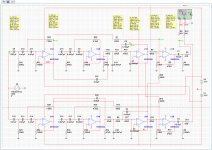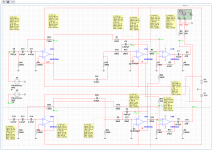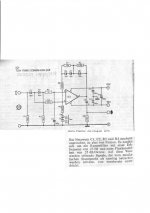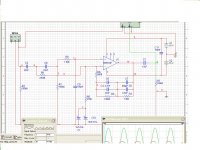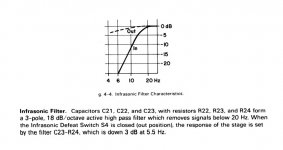Those of you with an interest in vinyl may be aware of the long thread on rumble filtering by removing subsonic anti-phase information (from vertical stylus movements) that has been running at:
http://www.diyaudio.com/forums/anal...is-why-some-prefer-vinyl-douglas-self-81.html
This has so far resulted in an article to be published in Jan Didden's Linear Audio in April, and a planned talk at the AES convention in Paris this June. Hopefully a PCB is going to be produced.
In the course of doing this, it struck me that very little seems to have been written about conventional subsonic/rumble filters, unless I've missed it. I would be glad to hear of any articles or papers you know about, and very interested to hear what people think is the ideal conventional rumble filter response.
I have a few ideas on this myself, but what do you think?
http://www.diyaudio.com/forums/anal...is-why-some-prefer-vinyl-douglas-self-81.html
This has so far resulted in an article to be published in Jan Didden's Linear Audio in April, and a planned talk at the AES convention in Paris this June. Hopefully a PCB is going to be produced.
In the course of doing this, it struck me that very little seems to have been written about conventional subsonic/rumble filters, unless I've missed it. I would be glad to hear of any articles or papers you know about, and very interested to hear what people think is the ideal conventional rumble filter response.
I have a few ideas on this myself, but what do you think?
Pardon my ignorance. I have been reading through diyaudio member montypig78's thread but most of it is way above my comprehension.
If I read correctly, the rumble and its proposed 'alleviator' schematics refer both to vinyl lps/vinyl 78's and 78rpm shellac records.
My naive question - is the rumble turntable or cartridge and tonearm related?
I play both vinyl and 78rpm shellac records and use Garrard 301's and Micro/Micro Seiki turntables.
bulgin
If I read correctly, the rumble and its proposed 'alleviator' schematics refer both to vinyl lps/vinyl 78's and 78rpm shellac records.
My naive question - is the rumble turntable or cartridge and tonearm related?
I play both vinyl and 78rpm shellac records and use Garrard 301's and Micro/Micro Seiki turntables.
bulgin
Not an article, but an advertisement.
There seems to be something amiss with the graph labelled
"Frequency response for signals applied to this channel only."
with frequency response deviations up to 400 Hz.
But this is all Off Topic. This thread is intended to canvass opinion on conventional rumble-filters- ie just filters, one per channel, with no crossfeeding or antiphase cancellation.
the only schematic i have with a rumble filter at the input.........but i have never built it.
This looks like an idea put forward by Tomlinson Holman in the 80's. I've never tried it either- I would be nervous that the noise performance would be impaired, and those relatively small caps at the input would make the circuitry after them very susceptible to capacitive pickup of hum etc.
'flankensteilheit' means 'edge steepness' which I assume is the rolloff slope, but I don't see how it could ever be 25 dB/octave. Could be a typo for 24dB/octave, of course, but the circuit looks like a second-order filter to me, which would give only 12dB/octave. There could be some subtle interactions with C4,C5 and C9 that yield 24dB/octave; a quick sim would answer that but for the reasons above this doesn't look like a promising path to explore.
Last edited:
Member
Joined 2009
Paid Member
If I read correctly, the rumble and its proposed 'alleviator' schematics refer both to vinyl lps/vinyl 78's and 78rpm shellac records.
My naive question - is the rumble turntable or cartridge and tonearm related?
I play both vinyl and 78rpm shellac records and use Garrard 301's and Micro/Micro Seiki turntables.
bulgin
My understanding is that with a half-decent turntable almost all the subsonic rubbish comes from disc warps, usually amplified by the cartridge/arm resonance . (say 8 -12 Hz) I very much doubt if 100kg platters do any good at all.
This looks like an idea put forward by Tomlinson Holman in the 80's. I've never tried it either- I would be nervous that the noise performance would be impaired, and those relatively small caps at the input would make the circuitry after them very susceptible to capacitive pickup of hum etc.
I'm quite ignorant of these things - are they also called infrasonic filters? That's what I found in a brief search of the Apt Holman service manual. If it's on topic, I can try to post the relevant sections.
If it's on topic, I can try to post the relevant sections.
Please do- post the lot!
You asked for the lot, here's the info dump 🙂
It's an RC filter, Butterworth. Sorry for the low res schematic, it's all I have. All this info comes from the Apt Holman preamp user and service manuals. In addition to the tech details, he mentions why it's needed. He applies it to all inputs, is that common?
From the manuals:
It's an RC filter, Butterworth. Sorry for the low res schematic, it's all I have. All this info comes from the Apt Holman preamp user and service manuals. In addition to the tech details, he mentions why it's needed. He applies it to all inputs, is that common?
From the manuals:
The selected input passes through a 3-pole, minimum phase Butterworth infrasonic filter to remove signals below the audio frequency range. The filter's response is flat +/- 0.5 dB at 20 Hz and above, is 3 dB down at 15Hz, and rolls off at 18dB/octave so that its response is down more than 30 dB at 4Hz, where the strongest warp signals and tonearm/cartridge resonance commonly occure. The filter also eliminates the the powerful infrasonic thump which FM tuners can generate when rapidly tuned off station. A switch on the rear panel permits the filter to be defeated for special testing purposes.
Phono and line inputs are all processed through this filter to prevent infrasonic noise from adding distortion to tape recordings or the power amplifier and loudspeakers. The group delay of the filter is 4 milliseconds at 50 Hz, while the limit of perception is over 100 milliseconds at that frequency. With the filter defeated the -3 dB frequency is 8 Hz.
Attachments
........made a sim
The response is shown as rolling off at -14dB/octave between 1 and 8 Hz.
That's weird.
You asked for the lot, here's the info dump 🙂
It's an RC filter, Butterworth. He applies it to all inputs, is that common?
Many thanks for that.
No, having the subsonic filter work on all inputs is not usual, though I have designed at least one preamp with that feature.
My understanding is that with a half-decent turntable almost all the subsonic rubbish comes from disc warps, usually amplified by the cartridge/arm resonance . (say 8 -12 Hz) I very much doubt if 100kg platters do any good at all.
Got it. Thank you🙂
Regds
bulgin
......what about a notch filter ? working in the 8 - 12 Hz region......
( lower frequencies than 8Hz could be attenuated with the caps in the (phono )preamp or so).
( lower frequencies than 8Hz could be attenuated with the caps in the (phono )preamp or so).
See circuit, attached PDF file
.
DA1, DA2 RIAA equalization with fully passive and separated filter left channel
DA3, DA4 RIAA equalization with fully passive and separated filter right channel
.
DA5.2 rumble filter left channel
DA5.1 rumble filter right channel
.
DA5.2, DA6 SUPER rumble filter left channel
DA5.1, DA7 SUPER rumble filter right channel
.
DA8, DA10.2, VT1, VT2 impulse noise blanker left channel
DA9, DA10.1, VT3, VT4 impulse noise blanker right channel
DA11, DD1, DD2 COMMON PART of circuit impulse noise blanker
.
DA12.2, DA13 stereo base enhancement left channel
DA12.1, DA14 stereo base enhancement right channel
.
DA15.2 output buffer left channel
DA15.1 output buffer right channel
.
Output level 500 milliVolts
.
Works with MM cartridge 5milliVolts and 1milliVolts
Works with MC cartridge 0.4milliVolts and 0.1milliVolts
.
.
DA1, DA2 RIAA equalization with fully passive and separated filter left channel
DA3, DA4 RIAA equalization with fully passive and separated filter right channel
.
DA5.2 rumble filter left channel
DA5.1 rumble filter right channel
.
DA5.2, DA6 SUPER rumble filter left channel
DA5.1, DA7 SUPER rumble filter right channel
.
DA8, DA10.2, VT1, VT2 impulse noise blanker left channel
DA9, DA10.1, VT3, VT4 impulse noise blanker right channel
DA11, DD1, DD2 COMMON PART of circuit impulse noise blanker
.
DA12.2, DA13 stereo base enhancement left channel
DA12.1, DA14 stereo base enhancement right channel
.
DA15.2 output buffer left channel
DA15.1 output buffer right channel
.
Output level 500 milliVolts
.
Works with MM cartridge 5milliVolts and 1milliVolts
Works with MC cartridge 0.4milliVolts and 0.1milliVolts
.
Attachments
Last edited:
Hi DouglasSelf and all,
when it is only headphones, issues are reduced to for one thing disc warping and for another thing pickup highpass, which should have a Q of zero point six. If its limit frequency is 16 Hz, it attentuates 1 Hz by 36dB. This may or may not provide enuff damping, depending on disc quality, sound pressure level and headphones tolerance.
When it is loudspeakers, room gain and compression chamber counteract the pickup highpass. So additional damping is almost always needed, a good starting point being a sealed enclosure loudspeaker with a limit frequency of 80 Hz or even higher. As loudspeakers also feed back to the platter and disc, sound shall be able to reach the platter-disc from both sides, and the turntable properly placed considering room modes.
I believe, that analogue tape machines have a second-order high-pass built in, too, with a limit frequency usually around 35 Hz. If lower limit frequency of human hearing range of 16 Hz is to become recorded and reproduced by analogue means, much care must be taken.
Uli
when it is only headphones, issues are reduced to for one thing disc warping and for another thing pickup highpass, which should have a Q of zero point six. If its limit frequency is 16 Hz, it attentuates 1 Hz by 36dB. This may or may not provide enuff damping, depending on disc quality, sound pressure level and headphones tolerance.
When it is loudspeakers, room gain and compression chamber counteract the pickup highpass. So additional damping is almost always needed, a good starting point being a sealed enclosure loudspeaker with a limit frequency of 80 Hz or even higher. As loudspeakers also feed back to the platter and disc, sound shall be able to reach the platter-disc from both sides, and the turntable properly placed considering room modes.
I believe, that analogue tape machines have a second-order high-pass built in, too, with a limit frequency usually around 35 Hz. If lower limit frequency of human hearing range of 16 Hz is to become recorded and reproduced by analogue means, much care must be taken.
Uli
Last edited:
My experience with a high grade truly differential Phono-Amp is that the best rumble filter is no rumble filter at all.
Using either the available 6dB/oct (-3dB@11Hz) or the 12dB/oct (-3dB@15Hz) Butterworth filter degrades the reproduction of the sound.
Hans
Using either the available 6dB/oct (-3dB@11Hz) or the 12dB/oct (-3dB@15Hz) Butterworth filter degrades the reproduction of the sound.
Hans
- Status
- Not open for further replies.
- Home
- Source & Line
- Analogue Source
- What is the ideal conventional rumble filter?- Douglas Self
